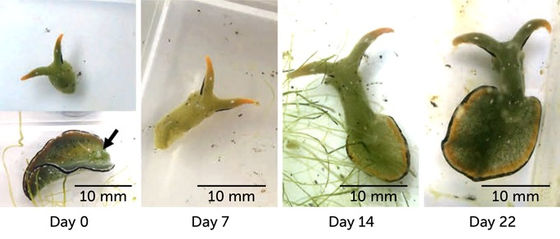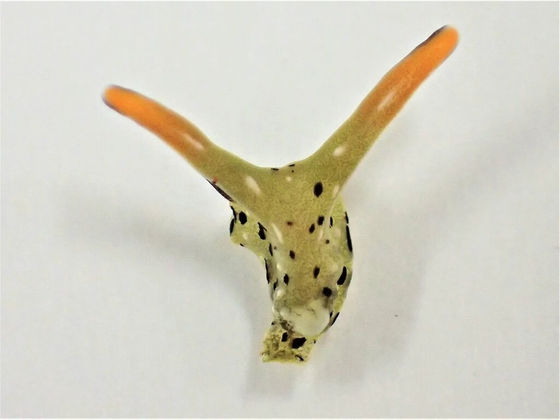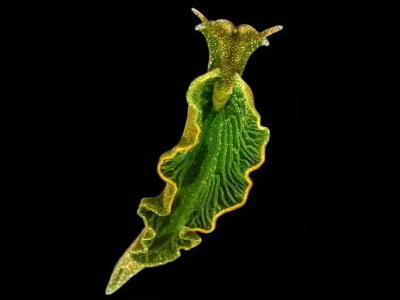You can find a sea slug that completely regenerates the torso after cutting the torso by yourself and becoming 'only the head'

Kiyoka Mito, a graduate student at Nara Women's University, reported on two species of sea slugs that have a strange ecology of 'cutting their own head and completely regenerating the whole body from that head.'
Extreme autotomy and whole-body regeneration in photosynthetic sea slugs --ScienceDirect
A sea slug's detached head can crawl around and grow a whole new body | Science News
https://www.sciencenews.org/article/sea-slug-detached-head-crawl-regenerate-grow-new-body
Meet the Sea Slugs That Chop Off Their Heads and Grow New Bodies --The New York Times
https://www.nytimes.com/2021/03/08/science/decapitated-sea-slugs.html
These Self-Decapitating Sea Slugs Can Grow an Entire New Body on The Old Head
https://www.sciencealert.com/self-decapitating-sea-slugs-can-grow-a-whole-new-body-internal-organs-and-all
A typical example of 'autotomy ' that cuts a part of the body by itself is the tail cutting of a lizard, but the sea slug newly reported by Mr. Mito cuts off 'everything except the head' instead of a part of the body. It has an unusual ecology of regenerating the body from the head. The existence of sea slugs that perform autotomy has been confirmed so far, but this is the first time that regeneration of the body including the heart has been confirmed.
It was a coincidence that Mr. Mito discovered a strange sea slug that completely separated the body. One day, Mr. Mito witnessed a sea slug autotomizing its torso and leaving only its head, but it was moving only on its head. He said that he overturned the stereotype that he should die.
Below is a video of one of the two species reported by Mr. Mito, 'Konohamidorigai', immediately after autotomy. Not only is the head and torso completely separated, but you can also see that only the head is moving around.
Elysia cf. marginata, just after autotomy --YouTube
In this way, Mr. Mitsuto, who started observing the Konohamidorigai who separated the body himself and became only the head, confirms that the Konohamidorigai who has only the neck starts eating food within a few hours after autotomy. And the cut surface of the neck was completely healed in one day, and the heart was regenerated in one week. It was confirmed that the whole body was completely regenerated 3 weeks after the observation. The images below are from left to right, on the 0th, 7th, 14th, and 21st days of autotomy. On day 0, the head (top) and torso (bottom) are completely separated, but it can be seen that the torso is gradually regenerating as the days pass. According to reports, some individuals succeeded in complete regeneration of the whole body twice, while older individuals died in about 10 days without eating food immediately after autotomy.

While the torso is completely regenerated from the head as described above, the original torso that has been separated responds to physical impact for several days to several months, but does not 'regenerate the head from the torso'.
It is believed that the reason why Konohamidorigai and Kuromidorigai, which have been reported to have the ability to completely regenerate the torso, separate the torso is to eliminate parasites that hinder spawning. All sea slugs that have undergone autotomy have been infected with parasites, have succeeded in eliminating parasites after autotomy, and sea slugs that have not been infected with autotomy should not perform autotomy. And the reason for this hypothesis is that cutting the torso can take several hours, which is not considered useful in situations such as lizard tail cutting that 'sacrifice if targeted by a predator'. is. In addition, in the case of Kuromidori-gai, which was infected with parasites only in a part of the body, it was confirmed that 'only the infested part is autolyzed and regenerated with regenerative ability'.
The ability to completely regenerate the body from the head has not been elucidated, but Mr. Mito thinks that it is related to the ability

The Nara Women's University Hydrosphere Ecology Laboratory, to which Mr. Mito belongs, is a laboratory that focuses on research on aquatic organisms such as sea slugs and shijimi. Professor Yoichi Yusa, who leads the laboratory, has set the kleptoplasty phenomenon in sea slugs as one of the main research themes, and announced a plan to disseminate the charm of sea slugs under the name of 'Nudibranch Lab' at the open campus. I am.
Related Posts:







